MSI GT70 Dragon Edition 2 By Xotic PC: Haswell Goes Mobile
MSI's GT70 Dragon Edition 2 is in the lab, tuned up by Xotic PC. Sporting a Haswell-based mobile Core i7-4930MX CPU, Nvidia's GeForce GTX 780M, and a luxurious 17.3" FHD screen, this is one heavy-duty gaming notebook. At more than $3000, it should be.
Turbo Boost Behavior And Throttle Testing
AC Power Vs. Battery Performance
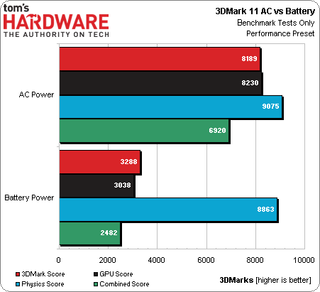
When you pull the AC power on MSI's GT70 Dragon Edition 2, you lose 60% of your gaming performance. However, a 3DMark score of 3288 is still fairly respectable, and able to outrun a GeForce GTX 660M. In other words, a number of games will still be playable, though the frame rates won't be nearly as compelling as what we saw over the past three pages.
Power consumption through this test was about 40 W. So, you can expect roughly two hours of run time in a game away from the wall.
System Throttling
Running Prime95 and FurMark at the same time places a very high load on any system, with both the CPU and GPU drawing maximum power while also generating maximum heat. In the GT70's case, the CPU is rated for up to 57 W and the overclocked GPU is at least 100 W. Add in 10-20 W for the other platform components and you're looking at 175 W or so.
It the system can't get more than 175 W from its supply, or isn't able to dissipate that amount of heat efficiently enough, it will throttle the CPU, GPU, or both in order to honor its thermal and electrical specifications.
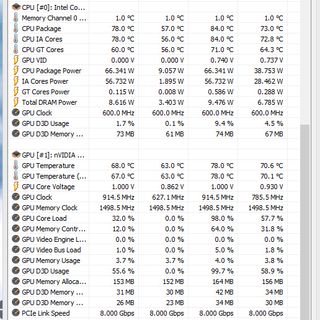
In the above screenshot, the CPU is operating under full load. The GPU is as well. With the cooling fan spinning as fast as possible, we observed the power supply pulling 179 W from the wall. This is not what we were expecting. Generously assuming 90% efficiency, 179 W at the wall is 162 W to the machine. With the CPU rated for 57 W, the overclocked GPU at 100 W, and the rest of the components pulling 10 W or more, the GT70 should be registering a little more than what we measured.
Stay on the Cutting Edge
Join the experts who read Tom's Hardware for the inside track on enthusiast PC tech news — and have for over 25 years. We'll send breaking news and in-depth reviews of CPUs, GPUs, AI, maker hardware and more straight to your inbox.
The day after I wrapped this story up, MSI sent us an updated BIOS for the GT70 Dragon Edition 2, changing the power consumption characteristics of the machine and increasing performance. Now the system pulls up to 194 W from the wall during games. Strangely, with a full synthetic CPU and GPU load, it only pulls 187, suggesting something is throttling back a bit. While this represents an improvement, there is still optimization work to be done.
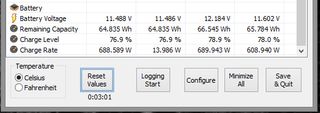
A look at HWInfo64 tells us where the GT70 was getting power, aside from its power brick. It actually pulls extra power from the system's battery. Obviously, the battery is not being charged at 688 W, but rather the amount of charge is falling. As you can see in the timer right below the “Reset Values” button, we were logging for about three minutes. If you look at the charge level, you can see that it dropped from 78.9% to 76.9%. The normal discharge rate was 1% every 90 seconds with the original BIOS. This rate dropped to 1% every 100 seconds with the new BIOS.
In MSI’s promotional literature, this behavior is marketed as a "feature" called NOS, which we'll be prodding over the next few pages.
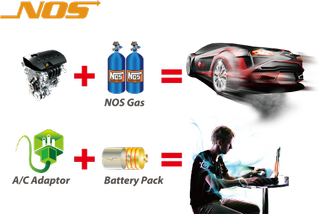
Normally, the extra power is used to keep Nvidia's GPU in boost mode. With the Xotic PC-tweaked configuration, the GPU is overclocked to keep it running faster than GPU Boost would permanently. As a result, any time the CPU and GPU are fully loaded at the same time, you're draining the battery. NOS allows the battery to discharge down to 30%.
With the new firmware, battery discharge rates are greatly decreased. Most games do not drain any power from the battery, though some that fully load the system still do.
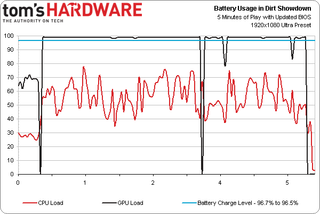
In DiRT: Showdown, which does balance CPU and GPU loading fairly well, we saw a 0.2% decrease in charge level over five minutes of play. This translates to a 2.4% drop in charge per hour of play.

The battery drain rate is highest in Crysis 3. We saw a 4.6% drop in charge level over 15 minutes of play in a particularly intense part of the game. Battery capacity drops at the rate of 18.4% an hour if you choose to play the “Welcome to the Jungle” level over and over again. In a less taxing sequence, battery drain is slower.
What happens when the GT70's battery drains to 30%? You'll find out just as soon as we present the results from our heat run, when we let the notebook suffer under the duress of maximum CPU and GPU load until the battery drops under 30% and NOS shuts down. But before we do that, let's look at the CPU's behavior.

Moving on to the Core i7's Turbo Boost performance, our chart illustrates what happens when the GT70's -4930MX is hit with a single-threaded load. One of the cores is almost always at 4.1 GHz. The smoothing in the graph masks how quickly the load is bounced from one core to another to tax the processor evenly. MSI's notebook essentially maintains 4.1 GHz in a single-threaded load forever.
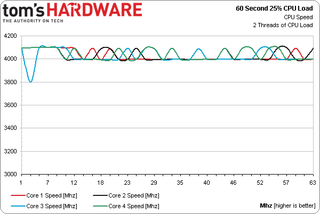
With two threads in flight, performance is essentially the same as single-threaded mode. There is some occasional switching down to 4.0 GHz, but the processor has no problem maintaining its clock rate.

Four threads changes the CPU's behavior substantially. The Core i7 holds 4.1 GHz for about two seconds (Prime95 was started at seven seconds), then quickly falls to between 3.8 and 4.0 GHz. After 28 seconds, the clock rate falls to about 3.5 GHz and stays there for as long as a load is applied. At that point, the benefit of a higher maximum Turbo Boost is gone.
In the chart below, we run the same load using MSI's more experimental firmware update.
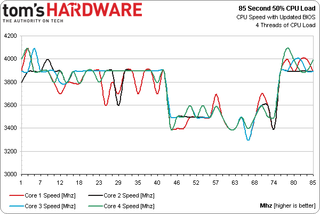
With the new BIOS, MSI's GT70 does hold onto higher Turbo Boost frequencies for longer. They still settle into the 3.4 to 3.6 GHz range, though. That jump at the end is where Prime95 was stopped and the cores returned to idle.
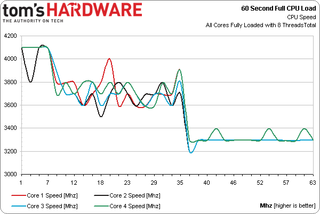
Fully loading the processor triggers an even more dramatic response from the processor. The 4.1 GHz Turbo Boost setting immediately falls (again, Prime95 was started at the seven-second mark) to between 3.6 and 3.8 GHz for 28 seconds, after which it falls once more to 3.3 GHz and remains there as long as the load is present. There were no heat or power issues to explain the rapid drop, though this is consistent with Intel's technology.
In the chart below, we run the same test using the newer firmware.
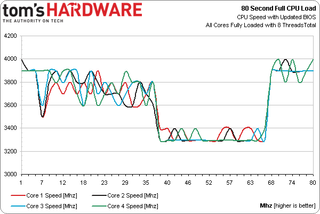
With the new BIOS, Turbo Boost clock rates stay higher for the first 28 seconds. The processor still settles to around 3.3 to 3.4 GHz, though. Again, the jump at the end is where Prime95 was stopped and the cores returned to idle.
These charts explain what we were seeing in the real-world productivity benchmarks. Lightly threaded apps benefit from the overclocked Core i7-4930MX processor, while more heavily threaded titles only benefit for short durations.
Still, neither the CPU nor the GPU throttled during testing. There is a drain on the battery when both subsystems are fully loaded, but the platform as a whole exhibited no worrying issues. Testing the CPU or GPU individually yields no battery drain, and each allows the battery to charge at full speed.
Current page: Turbo Boost Behavior And Throttle Testing
Prev Page Tomb Raider, Total War: Shogun 2, And WoW: Mists Of Pandaria Next Page Synthetic Heat Run And The Impact Of MSI's NOS-
cobra5000 My A10 laptop w/7660g may not have the specs but it plays great and only cost me $505.99.Reply
How about that for bragging rights! -
sha7bot Forbes magazine posted a great article on this system, as well. Seems like Alienware, ASUS, and Clevo have some serious competition.Reply -
lunyone I have an AMD a6 quad core CPU w/7670 dGPU that cost me <$400 and it will game okay for most things. Of coarse it's no screamer unit, but for 95% of what I do it works just fine. Yes I would have loved to had a better system for light gaming, but my laptop fit my budget. I wish that we got off this 1366 x 768 resolution and started out at 1600 x 900 for 11-15" laptops as a minimum, but that is just me.Reply -
Ducktor Please remove the term W/h from the text as well as "Watt per hour" from the graph on page 14. This unit is meaningless! 1W = 1J/s which is already a rate of power consumption. Dividing this unit by an hour yields 1W/h = 1J/3600s^2 which actually implies an acceleration in power consumption! Such mistakes are really hard to accept on a technical site like Tom'sReply -
danwat1234 Yea, the 180w ac adapter in this laptop, and also in the Gt60-2od laptop (the 15" version of this laptop) should really come with a ~240w AC adapter like what the Asus G750 has, but it doesn't. So they made NOS to adapt.Reply
It is unfortunate. What if I want to crunch on the high-end CPU and the GPU 24/7 for some reason? Can't do it with a 180w AC adapter.
To those thinking that the built in single fan isn't good enough, it is a 12V fan! I have never seen a 12V fan in a laptop before but this one has it. The Coolerboost feature ramps up the fan RPM to maximum and really keeps the temperatures down.
There are some reports of bad paste jobs so if you are having high temps, that may be the reason. Call up MSI to verify that your warranty will not be void and then repaste it. MSI is cool in that they'll usually allow you to take off the heatsink whereas Asus won't.
Thanks Tom's for making a much better review than what Anand did!
So on page 14, the max power draw from the battery when the laptop is unplugged and you are gaming is only 85 watts? That must mean that the dedicated graphics is shut down and the HD4600 is only on? Can you have the 780m when on only battery power? -
luckiest charm I would feel awkward using this machine in trains, at relative's places, or anywhere else I can be spotted on so I don't become a laughing stock. :PReply -
custodian-1 With the problem with cell phones being stolen I would not take something out of the case.Reply -
boro169 I think it should be noted that derived notebooks from this like deviltechs are much cheaper. the starting point of msi is 2400 euros in my country and deviltechs modified msi cost me 2050 with a 250gb samsung 840 and a 1 tb 5400 hdd and the 780m.. yeah it doesn't have the steelseries keyboard it has de gt60 blue blaclight one but...Reply
for those talking about its not for hardcore gamers... I think they are wrong because i can't take my cosmos II tower with the 3930x and my titan on my back when i visit my girlfriend on train a 300km away from my home... and not everybody can have two of those beasts.. the desktop is always better but you can't drag it always with you to trips...
for the one talking about being scared of being robbed... I don't know why he walks on the streets wearing a wallet you COULD be robbed... or a plane could crash on your head.... ¬¬ then nobody would buy an smartphone. because to use it indoor and using outdoors and old nokia because if it is robbed its not an expensive lose....
if you at least talked about the processing power lose when not wall plugged or so that would be a reasonable comentary... -
warezme You know the new Haswell GTX780m Alienware models have been out for awhile. You should have done your comparison with one of those. LIkely more expensive but more direct comparison.Reply
Most Popular

